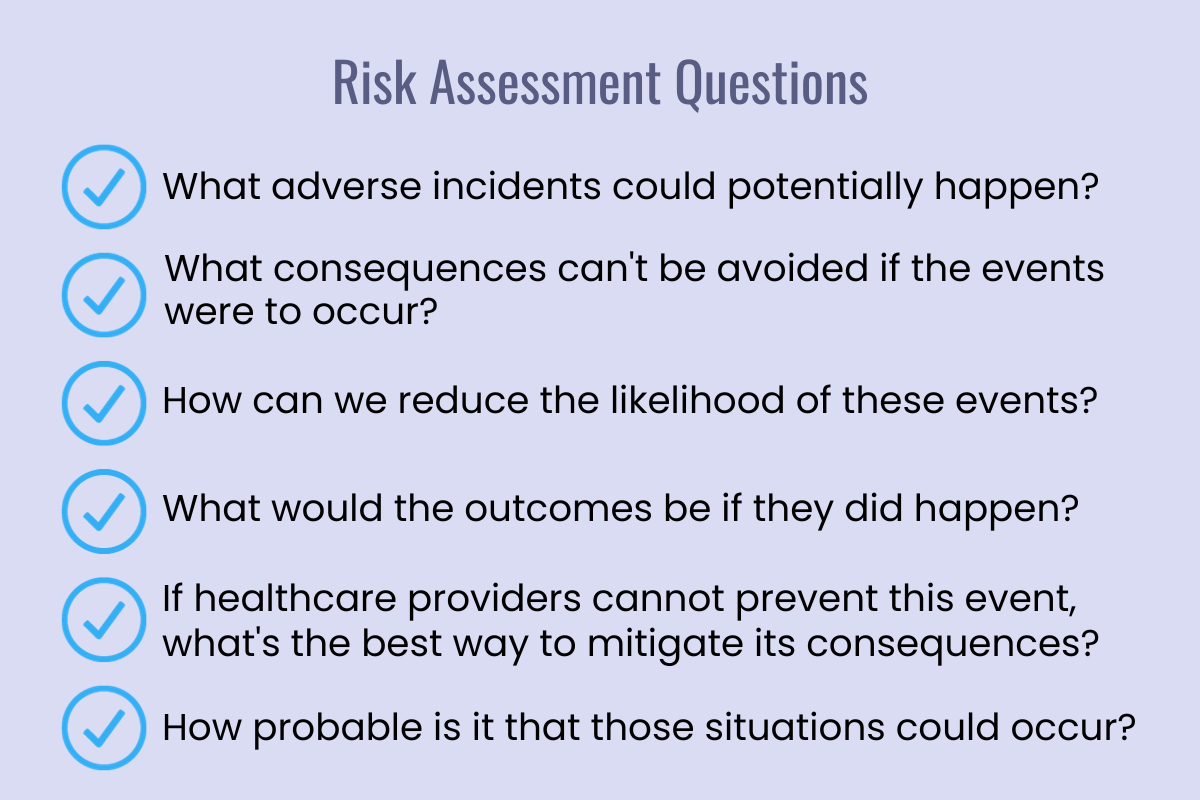5 min read
Avoid Unnecessary Risk: Fundamentals of Risk Management in Healthcare
Performance Health Partners
January 7, 2025
Risk management in healthcare is crucial due to the frequent exposure to risk that patients, staff, and organizations may experience. This necessitates the establishment of a thorough risk management program, which consistently identifies potential risk factors and implements procedures to address and mitigate those risks. This approach not only bolsters patient safety but also aids in maintaining an organization's brand reputation, obtaining accreditation, receiving reimbursements, and becoming a provider of choice.
What is Risk Management in Healthcare?
Risk is anything that can result in an unexpected outcome or loss. While risk is present in just about every industry, it can be particularly prevalent in healthcare. Risk can involve faulty equipment, workplace hazards, and medical malpractice, among other things. While risk cannot be avoided altogether, it can be addressed through risk management.
Risk management in healthcare involves analyzing organizational proccsses and practices, identifying risk factors that exist within them, and implementing procedures to uncover, mitigate and prevent risks to decrease patient harm and minimize financial loss.
The Evolution of Risk Management in Healthcare
Before the medical malpractice crisis of the 1970s, risk management in healthcare was largely reactive; leaders and staff wouldn't solve problems until they happened. Efforts were primarily centered around optimizing patient safety and reducing medical errors.
But as healthcare has transformed over the past few decades, it has become increasingly complex; risk management today encompasses everything from new healthcare technologies and cybersecurity concerns to the industry's ever-evolving regulatory, legal, political, and reimbursement environments.
Among healthcare reimbursement shifts is the movement toward value-based care, with bundled payment models and pay-for-performance initiatives becoming more common. As a result, financial risk is shifting from payers to providers and requires a broader view of risk management in healthcare.
A Moody's Investor Services report from 2017 emphasizes the link between risk management and a hospital's operating margins. It notes that "Maintaining high clinical quality will increasingly impact financial performance and reduce the risk of brand impairment as reimbursement moves away from a fee-for-service model and towards a greater emphasis on value and outcomes."
As a result, healthcare organizations are expanding their risk management programs from ones that are primarily reactive and focus on patient safety and preventing legal exposure to ones that are mainly proactive and view risk from a broader perspective of the entire healthcare ecosystem.
Unfortunately, while stakeholders understand the value of expanding risk management in healthcare, the transition to a more sophisticated approach has been slow.
The Role of the Risk Manager
While a proactive risk management system is key to mitigating and preventing risks, the program is only effective if the entire workforce is appropriately trained, knows how to execute strategies, and reacts to the unavoidable.
For example, a registered nurse should be able to identify a medication contraindication in new orders for a patient and to whom to report the incident. That person is typically the risk manager.
The role of a risk manager is to identify and evaluate risks to reduce incidents or to minimize the damages following an event within an organization. In addition, they develop, implement, monitor, and analyze risk management plans to reduce risk exposure and harm.

Assessing Organizational Risk
To develop an effective risk management plan, risk managers (and relevant stakeholders) must be able to predict and examine all potential outcomes for an organization's patients and workforce and have a plan to address or mitigate any issues that may arise.
There are several key concepts of risk management in healthcare and primary factors of concern to consider when assessing risks to create a risk management medical plan. They include but are not limited to:
- Improving patient safety and quality
- Adhering to mandatory federal regulations
- Potential medical errors
- Existing and future legislation
- Increasing quality and reducing risk
- Financial and non-compliance risks
- Data security
While it's not possible to predict every scenario regarding potential incidents, an organization must assess risk by identifying which types of risk are most likely to occur and how to manage adverse events if they do happen. In addition, potential risks must be evaluated and measured in terms of their possible adverse effects.
Conducting a risk assessment may involve asking questions such as:
- What adverse incidents could potentially happen?
- How probable is it that those situations could occur?
- What would the outcomes be if they did happen?
- How can we reduce the likelihood of these events?
- If healthcare providers cannot prevent this event, what's the best way to mitigate its consequences?
- What consequences can't be avoided if the events were to occur?
Developing a Risk Management Plan
Examining and analyzing the answers to these questions can help an organization establish policies to address potential risks. Then, based on the risk assessment, an organization-specific management plan should be developed, implemented, and monitored.
The development of healthcare risk management plans is based on extensive and ongoing research. Therefore, risk managers must stay current on relevant data within their organization and the healthcare industry. In addition, research findings could contradict speculations that otherwise shape risk management practices.
For example, a 2013 JAMA Internal Medicine study revealed that increasing the hours of sleep residents in teaching hospitals received while on-call compromised patient safety. The risk management outcome was to ensure that strategies were in place to improve residents' sleep schedules and ensure continuity of care.
As you develop your risk management plan, consider referencing the Department of Health and Human Services, the Food and Drug Administration, and the American Society for Healthcare Risk Management. These organizations provide resources to help you maintain compliance with laws, regulations, and best practices.
Patient-Specific Risk Management Strategies
Although risk management in healthcare continues to evolve and views risk from a broader perspective of the entire healthcare ecosystem, optimizing patient safety and reducing harm remain top priorities in risk management programs.
Risks posed to patient safety can be mitigated using patient-specific risk management strategies such as:
- Not filling expired prescriptions
- Following up on missing test results
- Tracking missed appointments
- Communicating with patients
- Preventing falls and immobility
- Sufficient record retention
Plans for risk management must cover patient-specific risks such as those listed above and be well documented; they must also be accessible to all employees working with patients.
Once developed and tested, these plans should be referenced for physician and provider training, communicated among staff members, and monitored – and revised when appropriate – to ensure success.
The Benefits of a Healthcare Risk Management System
An organization must correctly identify, analyze, and control risks to prevent incidents. In the healthcare industry, countless sources of information and data highlight the common risks to look out for, including those previously mentioned in this article.
However, each organization is unique; some healthcare organizations may face particular risks more frequently than others. This is why companies need to look at their incidents to inform their risk management program, as they can provide a great deal of insight into current risks and faulty processes.
Healthcare risk management technology and risk management tools for healthcare like incident reporting software enable organizations to capture hazards, near misses, and adverse events and analyze the information to identify risk areas. It also provides opportunities to develop interventions to mitigate exposure and reduce potential harm. There is a close correlation between establishing a centralized incident reporting system in a healthcare organization and patient safety.
Incident reporting systems make it easy for staff to report incidents, quickly notify the risk management team of events, and provide real-time data to enable organizations to identify underlying issues to prevent future incidents from reoccurring. As a result, with an incident reporting system, risks are reduced, costs are cut, and process efficiency is improved.
Implementing a Risk Management Strategy
Developing and implementing a risk management plan can be overwhelming, so let's take a simplified approach. If a healthcare organization wants to execute a risk management program, it could follow a simple process like the one below:
- Perform a risk assessment and develop an organization-specific risk management plan.
- Inform workforce on all aspects of risk management strategies, including how to prevent and respond to risks.
- Keep precise and comprehensive documentation, which can be reviewed and used as a reference in the future.
- Departmental coordination keeps all employees on the same page, expediting the risk management process and adding protection against malpractice insurance claims.
- Employees follow risk management strategies to prevent what is avoidable proactively.
- Employees react to unavoidable risks with speed and accuracy.
- Organization appropriately responds to and manages complaints.
- Incidents are reported using a centralized reporting system to reduce risks and prevent incidents from reoccurring.
Risk management in healthcare goes much deeper than the eight steps outlined above, but they are a good starting point.
When appropriately executed, a risk management plan can reduce patient health risks and minimize financial and liability risks. Subsequently, risk management in healthcare can enable organizations to achieve the best possible patient outcomes while improving financial performance.




